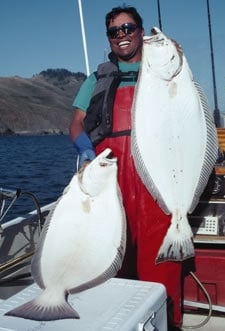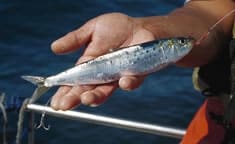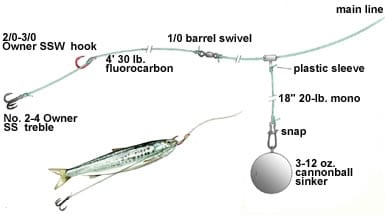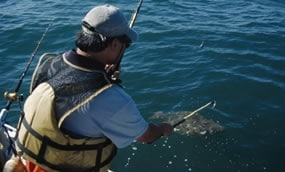
| The author hefts proof of how effective jumbo sardines can be on big California halibut. |
The place looked hot. Just a half-mile off San Francisco’s Ocean Beach, schools of “breezing” sardines were all over the surface – a sure sign that something below was making them nervous. After a quick check of the wind and current, I set up a drift and dropped four lines to the bottom rigged with live sardines. Minutes later, three rods were bouncing under the weight of hefty fish, and it didn’t take an expert to know what they were.
Needless to say, I had my hands full bringing in those fish single-handed, but soon the cooler was thumping to the beat of three hefty halibut weighing from 30 to 38 pounds. Just to play it safe, I sat on the lid to guard against any escapees. Large, sturdy coolers are necessary when you have to contain such big and unruly guests.
Dining on ‘Dines
The coastline from Point Reyes south to Half Moon Bay is a mix of sandy beaches broken by peninsulas, coves and small islands – a setting that’s tailor-made for halibut. And when jumbo sardines flood the central California coastline, as they did last summer, it sets the stage for some remarkable fishing. In addition to providing consistent action, the abundance of bait attracts considerably larger halibut.
Doormat-sized halibut love to dine on ‘dines, and when they find a school of these tasty tid-baits they gobble them down like so much candy. Yet trophy flatties can be finicky, even when faced with a surfeit of food. Once they get hooked on a steady diet of sardines you’ve got to “match the hatch” if you want to get bit.
Cyclical Sardines

Rigging large sardines with a treble-hook stinger will allow anglers to hook short-striking halibut.|
Sardines tend to be cyclical in our neck of the woods, but when they do show it usually occurs from June to October. And, of course, wherever the bait schools take up residence you’ll find the big halibut as well.
Last year, some of the better spots included Stinson, Muir, and Cronkite Beaches; the north bar off Point Bonita, and Bonita Cove. Heading south, steady action could also be had off San Francisco’s Seal Rocks, Ocean Beach and Thornton Beach. The last three areas were very productive for me last year. Between July and September, my brother Abe and I caught impressive numbers of fish in the 25- to 35-pound range, with my biggest weighing 43 pounds.
As ocean conditions moderate in late summer and early fall, sardines move closer to the beach, where they take up station in depths of 15 to 50 feet. To find the bait, I look for bird activity – and seals. Seals love sardines, so keep a close watch whenever you see pods of these marine mammals working an area. Look for big, brown patches just below the surface. These are the sardine schools getting attacked by predators, and they are easier to see with polarized sunglasses.
If live sardines are unavailable from the bait suppliers, it’s possible to catch your own on-site. I carry a few Sabiki bait-catching rigs and sinkers from one to two ounces to get the rig down. When I spot a sardine school, I approach it slowly until I’m within casting range, then lob the Sabiki over the school and allow it to sink. That’s usually all it takes to get some fresh bait. If the sardines aren’t showing on top, I use my depthsounder to locate them, then drop a Sabiki to the appropriate depth.
Sardines are rather delicate, so try not to handle them too much when transferring them to the bait tank. I grab the Sabiki’s leader and pull it downward while placing the edge of a butter knife under the bend of each little hook. A quick lift of the knife removes the hook and allows the bait to fall into the tank without me touching it. Make sure your live well has a good circulating system and that the tank is full of water before you start adding baits.
Tides & Tackle
| ### Live-Bait Drift Rig for Halibut |

¿|
For live-bait drifting, weaker tides and light winds are preferred, as a slow drift results in a more effective presentation, particularly when you need the bait to dangle in front of a finicky halibut’s nose a bit longer. Halibut also feed longer on the weaker tides, as well as on both sides of the tide. Should wind become a problem, making the drift too fast, you can always deploy a sea anchor off the bow.
Regarding tackle, I like a seven- to eight-foot rod with a sensitive tip and decent backbone. The rod should be rated for 15- to 25-pound line. In the reel department, I’ve had a lot of fun with Penn’s 975 loaded with 20- to 25-pound mono or with 50-pound Izorline Spectra braid.
The live-bait rigs used in this fishery are pretty simple to make. The main leader consists of approximately four feet of 30-pound fluorocarbon with a 1/0 barrel swivel at one end. At the business end, a 2/0 to 3/0 Owner SSW hook is snelled six to eight inches above the end of the leader. Next, a No. 2 to 4 Owner SS treble hook is tied to the very end of the leader. This “stinger” hook often proves invaluable when halibut are short-biting.
To complete the setup, a sliding sinker sleeve is added to the main line before it’s tied to the barrel swivel. The sleeve normally has a snap to which the sinker is connected. Remove the snap and tie on an 18-inch “dropper” of 20-pound mono with a snap on the end. To cover varying conditions, bring a selection of cannonball sinkers from three to 12 ounces to keep the gear on the bottom.
A “hot” sardine will always generate more action than a weak or tired one, so use your friskiest baits. When rigging the sardine, pass the point of the lead hook through the tip of its lower jaw and out the tip of its upper snout. The stinger hook can be either secured above the tail or allowed to swing freely alongside the bait.

Bring a halibut to gaff carefully, so as to eliminate the violent thrashing that can result in a lost trophy. |
Before setting up your drift, first determine the direction of the current and take note of the depth at which the bait is holding. Also, check to see if there are any contour lines or gradual drops along the bottom, as halibut tend to gather along such edges. If the bait happens to be there too, your catch numbers could really soar! For example, if I find a section of bottom that slopes gradually from 30 to 35 feet, and the place is loaded with sardines, I’ll target this depth line by moving upcurrent a considerable distance before dropping my baits.
To minimize tangles, stagger your lines. On my 17-foot Boston Whaler, I fish four lines. The midships rods are rigged with heavier sinkers, while the aft lines, run off the stern, are rigged with lighter weights. The exact amount of weight used should be determined by the water depth and the speed of the current, but always use enough weight to keep the rigs on or near the bottom.
There’s no limit on the number of lines you can fish for halibut; however, limit yourself to what you can handle comfortably. Extra lines are a big plus, since they allow for greater coverage of the bottom and can result in multiple hook-ups.
When the fish are holding in a certain area, they can be bunched up in small pods or scattered in pairs or singles. The latter scenario often occurs in open water, as is found off Stinson Beach, the North Bar off Marin, and San Francisco’s Ocean Beach. To cover the above areas effectively, long drifts are necessary.
The Strike Zone
To make sure the baits are in the right zone, strip out line until you feel the sinker ticking bottom. I like to keep the rods in horizontal holders, which keeps them close to the water. Also, I normally fish with a relatively light drag, and with the reel clicker on. The lighter drag allows the halibut to move off with the bait without feeling anything suspicious.
| ### Halibut HotlinesFor tackle and updated reports on the halibut scene, contact: * HI’s Tackle Box (415) 221-3825 * Oyster Point Bait & Tackle (650) 589-3474 * Outdoor Pro Shop (510) 532-2824 ¿ | |||
| For general reports and setting up charters, contact: * The Fish Hookers (916) 777-6498 * Barbarian Sport Fishing (707) 469-7585 * Jim Cox Sport Fishing (650) 369-3807 * Emeryville Sport Fishing (510) 654-6040 |
During the drift, watch the rod tips closely. Halibut are notorious for hitting short, and many times that’s all they do. If you get a tap, but no hook-up, it’s likely that your sardine has been attacked. Reel in and replace it with a fresh bait.
Train yourself to hold back on the strike. Halibut can be picky, but if you have a good, lively bait on the bottom, be patient and give the fish time to find it. If you see the rod tip bounce a couple of times, leave it alone.
Sometimes I’ll feed out a few feet of line right after the initial tap. This drops the bait on the halibut’s head, and will occasionally generate a hard strike. Set the hook when the rod loads up with solid weight.
Motor mooching can be effective when the tide slackens. To catch fish you need to cover water, and motor mooching gets you moving again. In motor mooching, the engine is popped into gear for a very short distance. As the line begins to angle upwards, the throttle is pulled back to neutral. The process is repeated, causing the bait to rise and slowly settle back to the bottom as you move along.
Sometimes a particular part of the drift will prove extremely productive, which can be due to a certain depth contour that the halibut like. Use your GPS or throw out a marker when you start getting strikes, then continue to fish that spot until it dries up.
It’s exciting when you latch onto a good fish, but remember that halibut often travel in pods. Once you hook that first fish, keep those other lines down and you might just get a double-, triple- or quadruple-header. If you and your friends ever find yourself in this crazy predicament, remember to take your time and work each fish away from tangles. When those flatties come to the boat, use a gaff or a large net to land them.
| ### Catch of the Day#### Poached Halibut Served over Creamy Basil Sauce |

¿ | |The Fish: * 4 6-8 oz. halibut fillets * 1 cup vegetable broth * 1 cup water * 1 lemon, sliced * 1 lime, sliced (additional hot water may be required) * 4 sprigs of basil for garnish|Basil Cream Sauce: * 4 tablespoons salted butter * 3 large tomatoes, peeled, seeded and chopped * 4 oz. button mushrooms, finely chopped * 1 shallot, minced * 2 tsp. flour * 1/4 cup white wine * 1 cup half-and-half * 3 tablespoons fresh basil, finely chopped * Pinch white pepper| | Fish: Pour broth & water into large sauce pan, add lemon & lime slices and bring to boil over low heat. Reduce heat until water is barely moving and carefully slide the 4 fillets into the liquid. If there is not enough liquid to cover the fillets add additional hot water to just cover them. Poach for 8 minutes per inch of thickness or until the middle of the fish is barely transparent. Remove the fillets.While the fillets are poaching prepare sauce.Sauce: Saut¿ shallots, tomatoes and mushrooms in the butter over medium heat until soft. Add the flour and continue cooking for another minute or two. Slowly add the wine and half-and-half and continue cooking for approximately 4 minutes or until the mixture thickens. Add the pepper and basil, and blend well.To serve, divide the sauce over 4 plates, place a filet on top of each, and add sprig of fresh basil.Serves 4|









